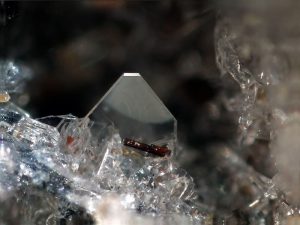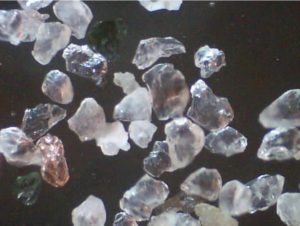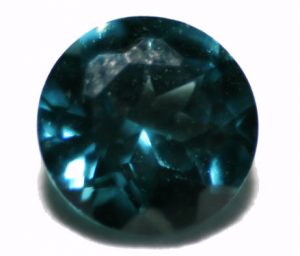Here is a collection of the unexpected compounds we have identified in the materials we have produced and some thoughts to ponder on that:
Grossmanite
From Wikipedia, the free encyclopedia
Grossmanite is a very rare mineral of the pyroxene group,with formula CaTi3+AlSiO6. It is the titanium-dominant member. Grossmanite is unique in being a mineral with trivalent titanium, a feature shared with tistarite, Ti2O3. Titanium in minerals is almost exclusively tetravalent. Grossmanite stands for titanium-analogue of davisite, esseneite and kus
Stuff to Ponder: Meteorites? CDP produces solid high velocity abrasive particles that impact a containment vessel, while at high temperature and at speeds estimated to be 6X the speed of sound. That sounds consistent with what I would expect from a meteorite impact, so perhaps studying CDP might also expand our understanding of this interesting field.
Forsterite
 From Wikipedia, the free encyclopedia
From Wikipedia, the free encyclopedia
Forsterite (Mg2SiO4; commonly abbreviated as Fo) is the magnesium-rich end-member of the olivine solid solution series. It is isomorphous with the iron-rich end-member, fayalite. Forsterite crystallizes in the orthorhombic system (space group Pbnm) with cell parameters a 4.75 Å (0.475 nm, b 10.20 Å (1.020 nm) and c 5.98 Å (0.598 nm).
Forsterite is associated with igneous and metamorphic rocks and has also been found in meteorites. In 2005 it was also found in cometary dust returned by the Stardust probe. In 2011 it was observed as tiny crystals in the dusty clouds of gas around a forming star. Two polymorphs of forsterite are known: wadsleyite (also orthorhombic) and ringwoodite (isometric). Both are mainly known from meteorites.
Stuff to Ponder: As with Grossmanite, Forsterite is ALSO associated with meteorites as well as comet dust and the dust around forming stars. When stars form, they go from very cold to very hot in what is assumed to be a rapid process of stellar ignition. Stellar ignition is thought to be the result of the accumulation of enormous amounts of hydrogen gas whose enormity is sufficient to permit the hydrogen’s collective gravity to create the density and pressure needed to cause nuclear fusion. This process would begin at the center of the hydrogens, which would be the center of a large dense hydrogen sphere.
CDP Synthetic Spinel
Spinel
Stuff to Ponder: Unexplained analytical results showing anomalous spinel in detonation byproducts lead us to correctly speculate that we can produce this mineral synthetically with CDP, by detonating CO2, magnesium and aluminum.
Anorthite

Anorthite is the calcium endmember of plagioclase feldspar. Plagioclase is an abundant mineral in the Earth’s crust. The formula of pure anorthite is CaAl2Si2O8.
Anorthite is the calcium-rich endmember of the plagioclase solid solution series, the other endmember being albite, NaAlSi3O8. Anorthite also refers to plagioclase compositions with more than 90 molecular percent of the anorthite endmember.
Anorthite is a rare compositional variety of plagioclase. It occurs in mafic igneous rock. It also occurs in metamorphic rocks of granulite facies, in metamorphosed carbonate rocks, and corundum deposits. Its type localities are Monte Somma and Valle di Fassa, Italy. It was first described in 1823. It is more rare in surficial rocks than it normally would be due to its high weathering potential in the Goldich dissolution series.
It also makes up much of the lunar highlands; the Genesis Rock is made of anorthosite, which is composed largely of anorthite. Anorthite was discovered in samples from comet Wild 2, and the mineral is an important constituent of Ca-Al-rich inclusions in rare varieties of chondritic meteorite.

Stuff to Ponder: We produced Anorthite in tests at a quarry with dry ice and a unique elemental magnesium particle size distribution. To set off the shot we used a detonator and cap-sensitive aluminized emulsion explosive, sensitized by glass microballoons. Within those initiation ingredients are the aluminum and silicon of Anorthite, however, there was no calcium source.
The initiation portion was very small and the sample was standing upright in a tall open canister. The initiation end of the sample was at the top and would be the first material to be vented, and very little CDP material was recovered from such a test. Considering how the remainder of the pipe below the initiation end would produce airborne CDP abrasive powders, this would effectively displace anything created by the initiation explosives. Therefore, there should be little to no aluminum or silicon, however, this cannot be confirmed.
Regardless, we made the same stuff that covers the Lunar Highlands. Oh, and there’s the Wild 2 Comet connection, too. And meteorites again?? It appears CDP makes things that are out of this world.
